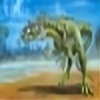HOME | DD
 EvolutionsVoid — Ladon
EvolutionsVoid — Ladon

#hydra #ladon #octopus #cephalopod #creature #monster
Published: 2023-06-23 23:35:34 +0000 UTC; Views: 4022; Favourites: 128; Downloads: 0
Redirect to original
Description
Imagine you are a bird, fluttering through the forest. Zipping through the air with your usual grace, navigating the twisting branches and shrouds of leaves. Finding your way around these woods is a breeze for you, but your sense of direction isn't the thing bothering you right now. It is a rumbling stomach, whining for food. Though your elegant wings give you mastery of the sky, it also burns through your fuel incredibly fast. You need to eat, but what is there to satisfy your appetite? Foraging on the ground is a risky situation, there are many agile and hungry predators down below. Instead, your eyes look to the branches, hoping to spot something tasty. Up there it will be much harder for fang and claw to reach you, especially on the thinner tree limbs. And then you see it! There! Like a lighthouse on a foggy night it cuts through forest's shadow! Fruit, vibrant and succulent! This tree is rife with it, more than enough to fill your belly! You find a free branch to perch upon, right next to a ripe looking meal. As you hop closer to inspect your meal, the branch bounces and sways. You do not fear it breaking, at least not with your light body. It is better that this branch be precarious, as it means larger hunters cannot approach. A quick look over shows the coast is clear, and your lunch is ready to be served. But as you are about to plunge your beak into the bright colored flesh, the branch shifts bizarrely. Before you can react, something lunges at you and fangs cut through feather and flesh. In an instant, you are crushed and swallowed. "How can this be?" you ask, except wait no you don't you're dead. Okay, before bird you dies you ask yourself "how can this be? I checked my entire surroundings for sign of a possible threat and detected not a thing!" Well to that I say, hold on, I don't think birds talk like that. Yes, I know birds can't talk, I mean if you translated them into our kind of talking, they probably wouldn't sound like that. Bird you would probably be like "SQUAWK! IMPOSSIBLE! SQUAWK!" Ah no, it wouldn't talk like a person and bird at the same time, that is just silly. Now bird you might be thinking- oh forget it! A bird landed on a branch to eat fruit and got eaten instead! You ask what could do that, and I say let me tell you right now!
So one would think that the thing that ate the bird crept up on it while it was investigating its meal, but in truth, it was there the entire time! Bird you, I mean, the bird we followed didn't realize it was already on the branch when it landed! Our subject for this entry is a crafty one, as it uses camouflage to hunt. But if you think the bird would have been safe if it perched on any other branch, you would be wrong! The creature is already there, waiting for its chance to strike! But how? Is it that fast, able to zip from limb to limb in order to pick off prey? Or is the whole tree infested with these nasty predators? Well, no, there is no group of hunters haunting this tree. It is, in fact, one single creature, but one with many arms! Or I guess you could say "heads," since our mystery predator is a kind of hydra!
Due to it being a member of the hydra family, some folk call it a "Wood Hydra" or a "Branching Hydra," but I tend to stick to the name the locals of the region give it: Ladon. It has the usual anatomy found in hydras, with the many beaked tentacles mimicking serpentine heads while the true one lies at the center of it all. It has clawed fins and a long mantle that has stretched into a slithering tail. What sets it apart from its brethren is its gnarled look, where its body and tendrils are covered in twisted, knotted growths. Add in a brown coloration, and you could mistake it for an old twisted tree if you squinted real hard. As the other names suggest, this comparison is intentional!
Ladons are ambush hunters, as was shown with the whole bird thing I tried to do. While some other hydras may hide themselves in shadow or burrows, the ladon chooses to hunt in plain sight! What it does is find a tree that shows promise, one that would attract a variety of prey. While each ladon's preferences may vary, the typical choice is a fruiting tree, be it actual fruit or mast. Such a food source ensures that someone is bound to show up, lured by this tempting bait. With its tree selected, the ladon will coil its long thin body around the trunk, aligning itself just right so that it flows with the natural shape of the tree. Next, its beaked tentacles will snake out and entwine themselves around branches with fruit on them. These tendrils target the most bountiful limbs, and are sure to wrap themselves tight so that they practically melt into the bark. Once settled in, the ladon will change it colors and skin texture to better match the tree it is camping out on. When this is done and all has grown still, the hydra practically vanishes before your eyes! I swear I could watch one set itself up on a tree and still have a hard time picking it out when the disguise is fully deployed! It is incredible at how they blend in so well! But it makes sense, because this is how they get food!
When a critter lands on the branch or climbs up for some fruit, the tendrils go on high alert. They are incredibly sensitive to movement, not just from the prey but from the branch they are coiled on as well! The ladon uses the bouncing of the branch to pinpoint where its prey is, and also how to move its tentacle so that its presence isn't detected. Thinner branches should have a lot of bend and give to them, but ones supported by a tentacle will be much hardier than usual, which could tip the victim off that something is wrong. However, the ladon masks this by having the tendril follow the natural movements of the branch, letting itself droop or flex with the weight of the new arrival. It is waiting for its prey to get caught up in its meal, and then it strikes. The beaked tips of these tentacles lash out with blinding speed, spearing prey on its claws and then crushing them with a powerful grip. It targets smaller prey like birds, squirrels and monkeys, any critter that would be found clambering about the branches. Since prey is not all that big or strong, the swift "bite" of the tentacle and strong grip is enough to dispatch them. Once this is done, the prey is "swallowed," sent down the hollow core of the tendril where muscle contractions and internal suckers slowly move it down to the true mouth. This method of eating means it doesn't need to uncoil from the tree to feed, which also means it doesn't have to blow its cover every time it snags food. It will simply sit there for weeks on end, eating anything that comes to its precious tree. Old tales claim that a ladon will latch onto a tree and never let go, remaining with it until one of them dies. Some even say death isn't enough to part it from its hunting spot, as they swear its locked muscles will keep the corpse clamped onto the trunk until decay or outside intervention finally pries them off!
While their method of hunting is certainly ingenious, it does cause some obvious problems when it comes to dealing with locals. It turns out, many other species like fruit trees, species that are way bigger then a little songbird and more armed too. Folks who go out to gather fruits and nuts in the woods may be in for a shock when the tree they decide to pick from fights back. When it feels threatened, it will use its tentacles to snap at foes, biting at them like a hidden viper. The gnarled protrusions can even harden too, making their limbs spiky and painful if they whack you with one. With this, ladons are often seen as minor threats or pests, with people quick to scare them off or dispatch them if they latch onto a popular tree. However, some folk actually like this behavior! I have heard that certain orchards actually keep ladons around, because they help eat other pests that may gobble up their precious crop! And when it comes time for picking, these creatures actually let the owners collect their fruit unharmed, as they have developed a kind of agreement. The orchard owner will let them have their tree and eat all the birds and squirrels they want, even throwing some extra morsels their way from time to time. In return, the ladon doesn't perceive the farmer as a threat, and thus lets them work on the tree without attack. Don't think, however, that that means any person can just pick from this orchard for free, as the hydra is only accustomed to the usual orchard workers. Any intruders will be met with biting tentacles, and that is just the way the farmer likes it! Extra security for their crop! It is pretty clever, though I feel it can be a bit mean. Yes, you don't want people picking your orchard clean, but couldn't you spare a few apples for a hungry soul? That might just be the dryad in me talking, but I feel such trees provide enough that this bounty can be shared! But then again orchards are usually businesses, and I recall businesses aren't exactly the sharing type...
Chlora Myron
Dryad Natural Historian
------------------------------------------------------------
Oh hey hydra! Would you look at that?
Related content
Comments: 6

👍: 0 ⏩: 0

👍: 0 ⏩: 1

👍: 0 ⏩: 1

👍: 0 ⏩: 0

👍: 0 ⏩: 1

👍: 0 ⏩: 0

















